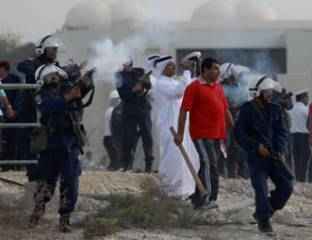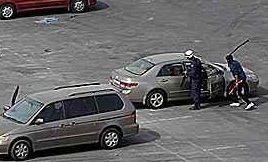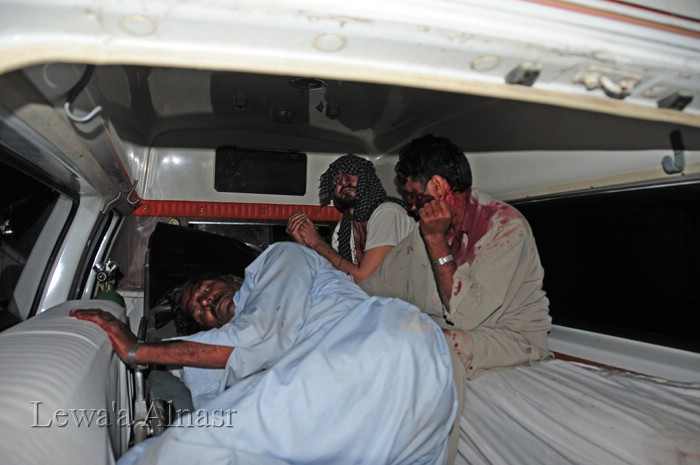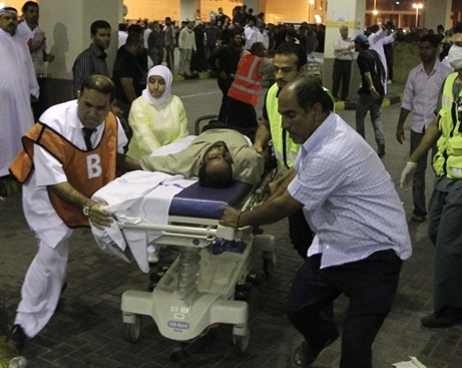Bahraini Doctors: A Thorn to the Regime - Part 4 - Terrorist Doctors vs Peaceful Thugs

2011-07-10 - 2:53 م
Bahrain Mirror (Exclusive): Bahrain TV showed a festive scene of the medical staff. They were chanting praise for Prophet Mohammed [a Shia custom], clapping and chanting “We are victorious and God is our sponsor”. The show presenter said that the scene was taken from Salmaniya Hospital that the doctors claimed had wounded people. Then the presenter pointed out to Dr. Ali AlEkri and dubbed him "the terrorist". That was when only a couple of days passed since Dr. Ali AlEkri had been arrested and the investigation had not be finished neither had he been tried. Who yet had not been tried, at the time this report was written, though he appeared before the military tribunal and had not been sentenced yet. Many jurists considered that military tribunal illegitimate.
That scene was posted on a sectarian web forum and presented by: “a disgusting scene of the thug, the physician Ali AlEkri clapping and dancing joyfully for appointing the sectarian Nezar AlBaharna as a Minister of Health replacing the magnanimous Faisal AlHamar who had been targeted by Rafedha [a derogatory name for Shia] because he only was a Sunni. The terrorist Ali AlEkri who turned Salmaniya Hospital into a prison, a torturing and a sit-in yard and Iranian and Safavi [derogatory for Shia referring to the period of Safavi era in Iran and the conflict with the Ottomans] filth, is dancing and celebrating the victory with a number of Shia physicians and Shia nurses. They showed their grudge and hatred to Sunni people after Allah had scandalized them and returned their mischievous scheme to their necks”.
A doctor protestingly said: “The official and non-official media of the regime try to portray the protesters, those who supported the protesters' demands, or who
treated their wounded in that tacky, sectarian, and treachery image”.
That was what that media promoted to paint the image of the “Safavi” and “terrorist” medical staff. In fact, the scene did not take place in Salamaniya Hospital. It was in Kuwait Health Center near to Malikiya village. It was the Health Center that was prepared for any emergency on the day that a mass demonstration was planned to march to Assafiriya Palace on March 12. It was so much feared that demonstration would be attacked by the security forces, especially that a demonstration on the previous day (the Royal Court demonstration in Rifa'a) was attacked profusely by tear gas after the demonstration finished. The protesters were attacked from the back during their return.
A member of the medical staff who was present at Kuwait Health Center said: “That scene took place after the Assafiriya demonstration, the doctors were joyous that the demonstaration had ended without any confrontations, and without any protester being hurt, before that the demonstration raised fearful expectations, and wearing the grave-clothes by its marchers was an indication to its potential danger”.
Another one commented: “With that manipulation, Bahrain TV and the official media continued to take photos and scenes out of their contexts and exploit them in other locations and different scenarios to stigmatize the protesters, the doctors, the intellectuals and the professionals as traitors and Safavis, just because they were Shia and demanded reforms”.
For that demonstration Dr. AlEkri suggested that the doctors to be available in the ambulances to quickly treat the critical cases instead of waiting till those cases arrive at the Health Center or a hospital. Walid AlManea (the hospitals CEO) confirmed that the ambulances that left for that demonstration were officially permitted. The doctors did not do that without following the administrative procedures as promoted by the regime and its media.
The Thugs (Baltagiyya)
 |
The injured were transported to Aali Health Center. Sources said that the number of injured exceeded that Health Center capacity. Some of the injured were transferred to Salmaniya Hospital. Three cases were admitted to the Resuscitation.
 |
The label thugs (Baltagiyya) was similar, because the act and the objective were similar, even the result. The difference was that the protesters in Egypt arrested the thugs and surrendered them to the army troops, but in Bahrain, those thugs were committing violence and sabotaging properties while the security were watching and protecting them. When the protesters went to the police stations and complained about that they were just told: "file a complaint".
Armed Men in Manama
 |
A number of Shia people were being tried in the martial tribunal for assault on Asian workers and others of the medical staff were being tried for detaining some injured Asians in Salmaniya Hospital.
An ambulance surrounded by a large crowd opened its door. Several handcuffed Asians got off. The angry crowd was about to attack them. That scene was showed on Bahrain TV on March 17, 2011. Then the show presenter commented: “Those criminals and outlaws used the ambulances not to transport the patients to where they got the treatment, but as a terrorism mean to transport the innocents to where they would be tortured”. Then wondered: “Are those inhumane and immoral practices what those outlaws demanded who claimed that they had legitimate demands?”
An eyewitness of the medical staff responded: “I don't like to justify. But the question that was not posed by Bahrain TV report and neither will be posed is what made that crowd furious with that group of Asians? We are a population that has lived peacefully with Asians for a long time. Why specifically at that time they were attacked? What that group of Asians did that agitated the people to that level of fury that was shown on the TV scene? Why didn't we witness any attacks before that incident neither after it?”.
What was the untold story in that scene?
 |
Another team of those Asians threw stones and bricks on the passers-by from the roofs of the buildings. A woman said: “I was walking in the alley with a relative when we were attacked by stones from the roof of a building, one fell on my foot”.
SMS messages were circulated quickly. A number of the youths taking part in the sit-in in the roundabout hurried to stop the attack. The young men living in the area came out of their homes to defend their people. The clashes started between the two parties. A young man said “We had to defend oursleves and relatives. They were paid to threaten the others people's lives and to provoke horror and chaos, it was not right to leave them in our residential area daunting and attacking our relatives and keep silent about it”, he added: “self-defense is a peaceful act [in defense of the revolution Peaceful motto]”
Another added: “The young men in the area had no choice but to confront them. A large number of them were security troops. To whom could we complain them? The Asians fled to hide in the houses of their country men living in the area. The clashes lasted for a long time. Later some Asians who were resident of the area joined the clashes.”.
And Angry Crowd in Salmaniya
In Salmaniya Hospital it was paged that there were injuries in both sides. The ambulances left to fetch the injured accompanying some doctors, Dr. Ghassan Dhaif was one of them. One ambulance returned with the injured citizens, and the other fetched the injured Asians. Twelve severe injuries were among the Asians. Some of them were military people. One of the eyewitnesses said: “While the medical staff were treating them, we were surprised that one of the Asians was wearing his military uniform under his outer clothes”.
 |
One of the eyewitnesses said: "I heard Dr. Ali AlEkri yelling at the crowds: What's up with you? We want to work We are not able to treat our patients, you are disturbing us."
A female doctor went in the ambulance to fetch the wounded from both sides. She said: "When we reached the clashes were raging between the two sides. The Asians were holding cold weapons. The youths restrained some Asians and tied their hands them to stop their attacks. The injuries were in both sides. We were attacked by the Asians. They were violent and frightening. We transported the injured from each side in a different ambulance. I was in the Asians ambulance. I was offering them first aids, when one of them yelled at me to untie his bonds. I was scared that he would attack me. I didn't respond to him. I offered him the needed treatment till we reached the hospital".
Not sooner had the injured Asians received the primary care by the Emergency Department doctors than a call from the Ministry of Interior came to to transfer them to the Military Hospital. They were transferred at that night.
The armed gangs did not stop. A series of terrorist attacks swept the villages. Armed men wearing balaclavas and holding cold weapons, iron rods, and sticks attacked the people. Eight Bangladeshis were treated at the Subah AlSalem Health Center. The injuries were of different degrees, when the doctors wanted to transfer them to Salmaniya Hospital they refused and said they wanted to be taken to the Military Hospital.
Dr. Ghassan Dhaif went in an ambulance to save the injured Asians and tolerated the crowd rebuke when he tried to calm them so that the paramedics could take those injured to the Resuscitation Room. He let a policeman guard the Resuscitation Room where the injured stayed safe from the angry crowd attacks. Dr. Dhaif was being charged for detaining the Asians as hostages. The doctors protected the injured Asians from the angry protesters. But that protection was used against them. Had the doctors wanted to harm the injured Asians they would have left them bleed in the streets Why did they exert the effort to bring them and face the angry crowd?
اقرأ أيضا
- 2024-07-10Bahraini Authorities Summon Head of Sanabis Ma'tam, Threaten "Actions" Due to Mourners' Chants Against Israeli Occupation
- 2024-07-10Political Prisoner Mohammad Al-Raml's Family Say He's Vomiting Blood Due to Poor Conditions, Fear for His Life
- 2024-07-09Ali Al-Majed Arrested After His Return to Bahrain
- 2024-07-08Yusuf Al-Muhafdha: Convicted Returnees to Bahrain Have the Right to a Lawyer, Retrial, and Legal Guarantees
- 2024-07-08Reciter Mahdi Sahwan: Head of Manama Police Informed Me of Ban on Reciters Traveling to Commemorate Ashura
